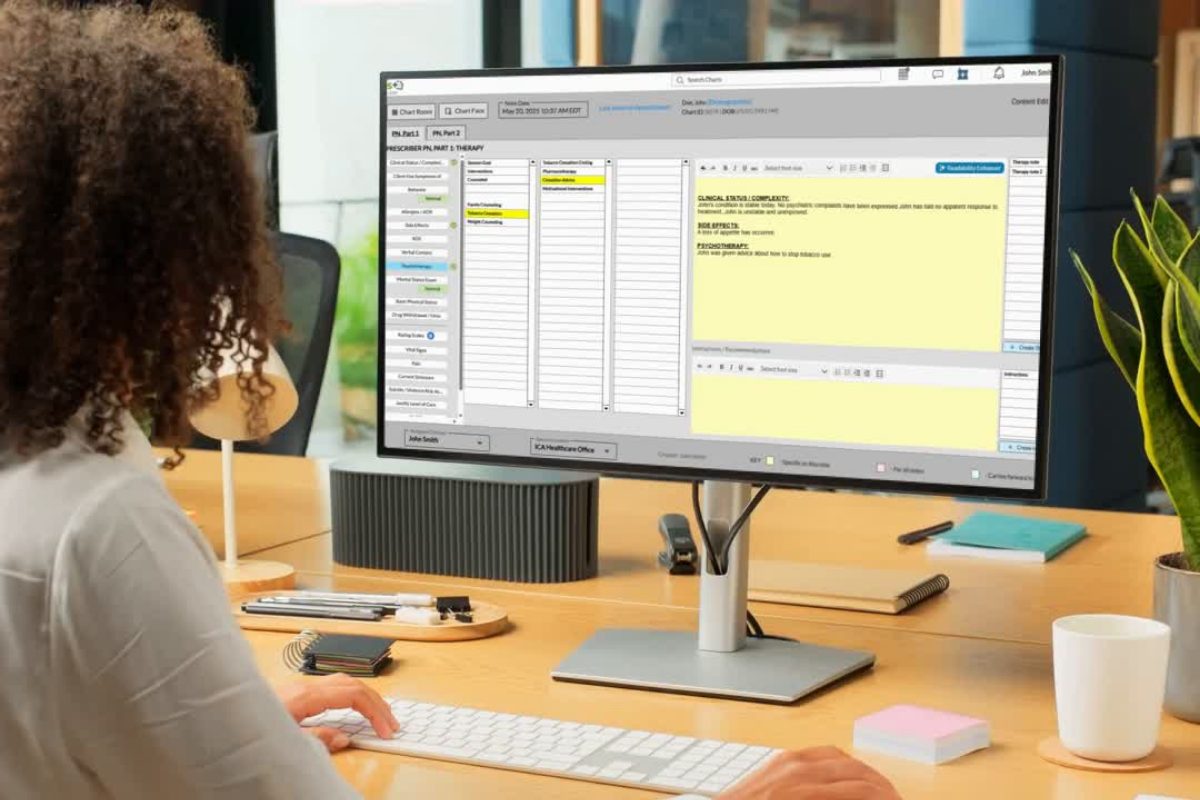Blog > Documentation > Substance Abuse Notes: Real Progress Note Examples for Addiction Counselors
Substance Abuse Notes: Example Progress Notes and Tips for Clinicians
Effective substance abuse notes help clinicians document treatment progress, demonstrate medical necessity, and ensure continuity of care. This guide explores what to include, offers substance abuse progress note examples, and provides practical tips for writing organized, concise documentation that strengthens therapeutic care.

Last Updated: October 17, 2025

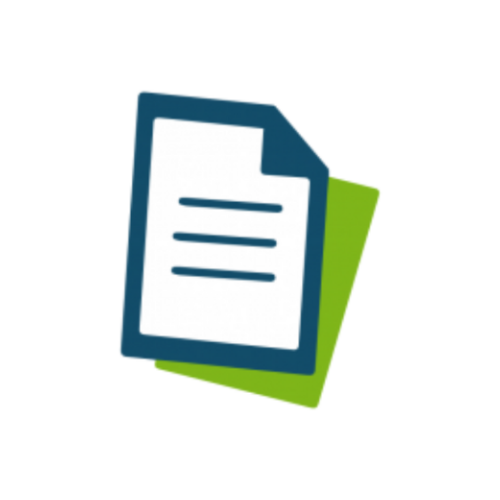
What You'll Learn
-
The core components every substance abuse note should include, from patient identifiers and CPT codes to progress tracking and clinician signatures.
-
How to write compliant, clinically useful substance abuse progress notes that demonstrate medical necessity and continuity of care.
-
The key differences between SOAP, DAP, and narrative formats, with real-world examples of each.
-
Substance abuse progress note examples for individual, group, and relapse-prevention sessions.
- The most common documentation errors clinicians make in substance abuse notes and how to avoid them.
- Six practical tips for success that improve accuracy, reduce audit risk, and save time when documenting sessions.
Contents
- What are Substance Abuse Notes?
- Common Formats for Substance Abuse Notes
- Substance Abuse Progress Note Examples
- What to Include in Substance Abuse Progress Notes
- How to Write Effective Substance Use Notes
- SOAP Note Example for Substance Abuse Counseling
- Common Errors to Avoid
- 6 Tips for Success
- FAQ: Substance Abuse Notes
Clinicians working in addiction counseling know that documenting substance abuse notes can be as complex as the treatment process itself. Every entry needs to capture the client’s story, track progress toward recovery, and meet compliance and billing standards — all without taking time away from therapeutic care.
In this post, you’ll find practical substance abuse progress note examples and templates that reflect best practices in behavioral health documentation. We’ll also cover what to include in each note, how to adapt formats like SOAP or DAP, and how tools like ICANotes make accurate, audit-ready documentation faster and easier.
What are Substance Abuse Notes?
Substance abuse notes, also called addiction counseling notes or substance use treatment notes, are the clinician’s written record of each session with a client receiving care for substance use disorder. These notes document the client’s symptoms, treatment interventions, responses, and progress toward recovery goals.
Because substance use treatment often involves multidisciplinary teams, detailed and consistent documentation supports collaboration between therapists, case managers, prescribers, and recovery coaches. Accurate notes also protect the clinician and the client by ensuring transparency, demonstrating medical necessity, and satisfying payer or accreditation requirements.
A high-quality substance abuse note should clearly answer:
-
What brought the client to treatment today?
-
Which interventions or therapeutic techniques were used?
-
How did the client respond during the session?
-
What’s the next step in the treatment plan?
Depending on your practice, you may be able to share your notes with your client, which can help them visualize their own progress and help prevent them from repeating past behavior. Sharing notes can also help you form a stronger client-therapist relationship and encourage your patient to engage more in their treatment. You may also be able to share your notes with other clinical staff if necessary to communicate about your client's overall care and substance abuse treatment plan.
Download Our Guide to Writing Better, Faster Clinical Notes
Streamline your progress notes, avoid documentation pitfalls, and stay compliant with practical templates, note formats (SOAP, DAP, BIRP), and time-saving tips to write high-quality, defensible notes faster.
Common Formats for Substance Abuse Notes
Clinicians often structure substance abuse notes using familiar frameworks like SOAP, DAP, or narrative formats. Each offers a slightly different approach to organizing clinical information while meeting documentation and compliance standards. Choosing the right one depends on your workflow and payer requirements:
SOAP (Subjective, Objective, Assessment, Plan):
The SOAP format provides a structured and clinically focused way to record each session. It’s especially effective in multidisciplinary or medical settings.
Example SOAP Note:
S: Client reports cravings have decreased since starting group therapy.
O: Appeared calm, alert, and engaged throughout the session.
A: Demonstrates increased insight and motivation toward recovery goals.
P: Continue group therapy twice weekly; review coping strategies for upcoming weekend.
Why it works: SOAP notes create a clear, logical progression from the client’s experience to your clinical assessment and next steps, ideal for audits and interdisciplinary coordination.
DAP (Data, Assessment, Plan):
The DAP format is a concise alternative widely used in behavioral health documentation. It simplifies note-writing while still ensuring that each note tells a complete clinical story.
Example DAP Note:
D: Client discussed feeling anxious about maintaining sobriety during social events. Reported using grounding techniques to avoid urges.
A: Appears motivated and engaged; demonstrates improved awareness of triggers but still struggles with boundary-setting.
P: Role-play refusal skills in next session; encourage journaling after social gatherings to reinforce coping strategies.
Why it works: The DAP format removes redundancy and keeps notes streamlined, making it a favorite for outpatient counselors who write multiple substance abuse notes each day.
Narrative Format
A narrative or free-form note can be useful in certain therapy modalities, such as motivational interviewing or client-centered work. However, it should still include objective details and a clear link to treatment goals.
Example Narrative Note:
Client reflected on progress since detox, expressing pride in remaining sober for 45 days. Explored unresolved guilt related to family relationships. Clinician used motivational interviewing to reinforce strengths and highlight continued recovery milestones.
Why it works: Narrative notes allow for richer storytelling but should remain concise and clinically focused to avoid drifting into personal journaling or excessive detail.
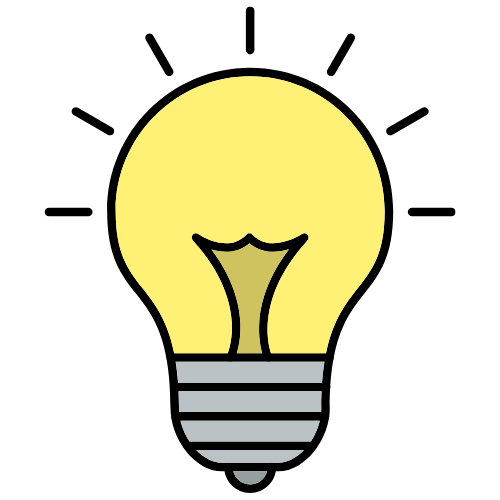
Tip for Clinicians
Whether you prefer SOAP, DAP, or narrative notes, ensure every entry connects to the client’s treatment goals. This “golden thread” demonstrates medical necessity and helps maintain compliance across the full course of care.
Substance Abuse Progress Note Examples
When writing substance abuse progress notes, it helps to start with clear, consistent language that reflects both clinical accuracy and compassion. Below are sample progress note examples you can adapt for different treatment settings. Each follows best practices for documentation while remaining brief enough for everyday use.
Example 1: Individual Counseling Session
D: Client reports maintaining seven consecutive days of sobriety and attending three support group meetings. Expressed anxiety about an upcoming family event involving alcohol.
A: Demonstrates improved insight and coping strategies; remains at moderate relapse risk due to social triggers.
P: Continue exploring cognitive reframing techniques; review relapse prevention plan in next session.
Clinical Insight: Including both progress and potential risk factors helps demonstrate ongoing medical necessity, a key component of compliant substance abuse documentation.
Example 2: Group Therapy Session
D: Client actively participated in a relapse prevention group. Shared coping strategies and offered peer support to others.
A: Exhibits growing self-efficacy and group engagement; reports lower cravings during evenings.
P: Encourage continued attendance; assign journaling activity on triggers and coping skills.
Tip: When documenting group therapy, emphasize the client’s participation, emotional tone, and peer interaction — not just attendance.
Example 3: Relapse Prevention Follow-Up
S: Client called after experiencing mild cravings but reports using breathing exercises to de-escalate.
O: No physical withdrawal symptoms observed; mood appears stable.
A: Effectively applying coping strategies from previous sessions.
P: Reinforce relapse prevention plan; consider booster session before high-risk events.
Tip: These substance abuse progress note examples show how linking your note to prior treatment goals strengthens the “golden thread” across all client documentation.

Tip for Clinicians
ICANotes provides prebuilt menu-driven note templates and treatment plans for addiction treatment, group therapy, and relapse prevention, designed to help clinicians document faster while maintaining accuracy and consistency.
How to Write Effective Substance Abuse Notes
Writing strong substance abuse notes requires balancing thoroughness with efficiency. Each note should tell a concise, factual story of the client’s treatment journey and demonstrate that care is ongoing, goal-directed, and clinically justified.
Here are key strategies to improve both clarity and compliance:
1. Use Objective and Measurable Language
Replace subjective statements (“Client is doing better”) with observable facts (“Client reports reduced cravings and improved sleep”). Objective data supports clinical decision-making and insurer requirements.
2. Connect Notes to the Treatment Plan
Each entry should tie back to a documented goal or intervention. For example, link relapse-prevention discussions to the long-term goal of maintaining abstinence.
3. Include Both Strengths and Challenges
Document not only symptoms or setbacks but also coping progress, motivation, and engagement. This balanced approach reflects the client’s full clinical picture.
4. Protect Confidentiality
Avoid unnecessary detail that could compromise privacy. Use professional language and refrain from quoting sensitive disclosures verbatim unless clinically relevant.
5. Keep the “Golden Thread” Visible
From intake to discharge, each substance abuse note should logically connect to the previous one. Consistency shows progress and ensures that care is defensible in audits or reviews.

With ICANotes:
ICANotes makes it simple to create compliant, detailed substance abuse notes with structured templates and built-in prompts. Whether you’re documenting an individual therapy session or managing a group program, ICANotes ensures every note meets payer and accreditation standards, no copy-pasting required.
What to Include in Substance Abuse Progress Notes
Every clinician’s substance abuse note should tell a complete, compliant story of the client’s treatment progress — not just what happened in session, but also who was involved, when it occurred, and how it connects to the overall treatment plan.
Whether you use SOAP, DAP, or another structure, each note should include both administrative identifiers and clinical content to meet documentation and billing standards.
Administrative and Identifying Information
These details appear at the top of every clinical note and help ensure accuracy, compliance, and reimbursement:
-
Client Information: Full name, date of birth, and client ID number.
-
Session Information: Date, time, duration, and type of service (e.g., individual, group, telehealth).
-
Clinician Information: Name, credentials, and contact information.
-
Diagnosis Codes: ICD-10 diagnosis (e.g., F10.20 - Alcohol Dependence, Uncomplicated).
-
Procedure Code (CPT): Billing code corresponding to the session type (e.g., 90834 for 45-minute individual psychotherapy).
-
Clinician Signature and Date: Required for record authenticity and audit compliance.
Tip: Electronic systems like ICANotes automatically populate most of these fields, reducing manual entry and ensuring no required element is missed.
Clinical Content
Once identifying details are in place, the body of the note documents the clinical interaction and client progress.
-
Presenting Problem: Describe the reason for the session or focus of care (e.g., cravings, relapse prevention, coping skills).
-
Interventions Used: Note therapeutic techniques such as CBT, motivational interviewing, or relapse prevention planning.
-
Client Response: Record the client’s affect, engagement, and behavioral changes observed in session.
-
Progress Toward Goals: Link the client’s current status to their treatment plan objectives (e.g., maintaining abstinence, improving emotional regulation).
-
Plan for Next Session: Include specific actions, homework, or session goals that move treatment forward.
Pro Tip: Keeping these sections consistent across all notes helps create a clear “golden thread,” a documented link between the treatment plan, session notes, and measurable outcomes.
Compliance and Best Practices
-
Use objective, nonjudgmental language.
-
Avoid over-documentation or repeating identical text from prior sessions.
-
Ensure all required fields are complete before signing and locking the note.
-
When applicable, document collateral contacts (e.g., family members, case managers) involved in treatment.
With ICANotes: These elements are built into each clinical note template, so clinicians don’t have to remember what to include. Simply select the session type, and ICANotes prompts you to record all the necessary details — including CPT code, diagnosis, and electronic signature — for fully compliant documentation.

SOAP Note Example for Substance Abuse Counseling
S – Subjective:
Client reports three weeks of sobriety and expresses relief over reduced cravings. Mentions mild stress related to family conflict.
O – Objective:
Client presented on time, alert, and cooperative. Affect congruent with topic. No signs of intoxication or withdrawal.
A – Assessment:
Progressing toward long-term abstinence. Continues to demonstrate insight and apply cognitive-behavioral strategies. Mild psychosocial stressors persist.
P – Plan:
Continue weekly sessions with focus on stress management and family communication. Encourage ongoing attendance at 12-step meetings.
✏️ Clinical Insight: SOAP notes help structure your thinking while satisfying payer and accreditation documentation standards, especially when each section connects back to measurable treatment goals.
Common Errors to Avoid in Substance Abuse Notes
To help make your note-writing process more streamlined, take a look at some common errors that occur when documenting notes and how you can avoid them.
General Statements Without Supporting Data
As a rule of thumb, you should avoid making general statements or including your personal opinions or judgments, especially without any evidence or supporting data that helped you draw those conclusions. If you're writing SOAP notes, for example, your objective section should stick to clearly identifiable facts and specific observations. Without this supporting data, your statements are merely opinions.
Vague Language
Reading through pages of vague notes can make it difficult to follow along and remember key details about your client. If you have to share your notes with other clinicians, you might need to provide more context. Irrelevant information that does not pertain to the client's substance abuse disorder or your session and treatment plan should be left out of your notes.
Likewise, using overly descriptive language can cloud your notes and make your reviewing more time-consuming. When writing any type of therapy note, be straightforward, clear and concise about your client's progress, reactions, statements and needs.
Repetition
Though you may find yourself wanting to restate important details to emphasize major changes or life events for your client, this will usually make your notes longer, not more effective.
Instead of repeating certain details, compare and contrast progress from previous sessions and determine what adjustments can be made or solutions you can introduce that you have not tried yet. Once you write down your substance abuse notes, try to avoid summarizing them again.
Making Adjustments Instead of Rewriting
As your client progresses through therapy, you'll likely need to make several changes to their treatment plan and homework exercises. Instead of rewriting your entire treatment plan every time you need to make an adjustment, modify the existing plan where necessary and record the changes you've made so far to the plan along the way. Specify what immediate steps you and your client will take to get closer to the set goals, but don't waste your time rewriting everything when you may only need to make a simple adjustment.
Other common mistakes to avoid include:
- Illegible handwriting
- Failure to sign your notes or include the date and time
- Incomplete or missing documentation
- Adding entries at a later time
- Using incorrect abbreviations
- Writing information in the wrong chart
Access Our Sample Notes Library
Get instant access to our full library of sample behavioral health notes, including Initial Evaluations, Progress Notes, Treatment Plans, and Discharge Summaries. We have note samples for psychiatry, therapy, case management, PRP, substance abuse, group therapy, couples therapy, and more!
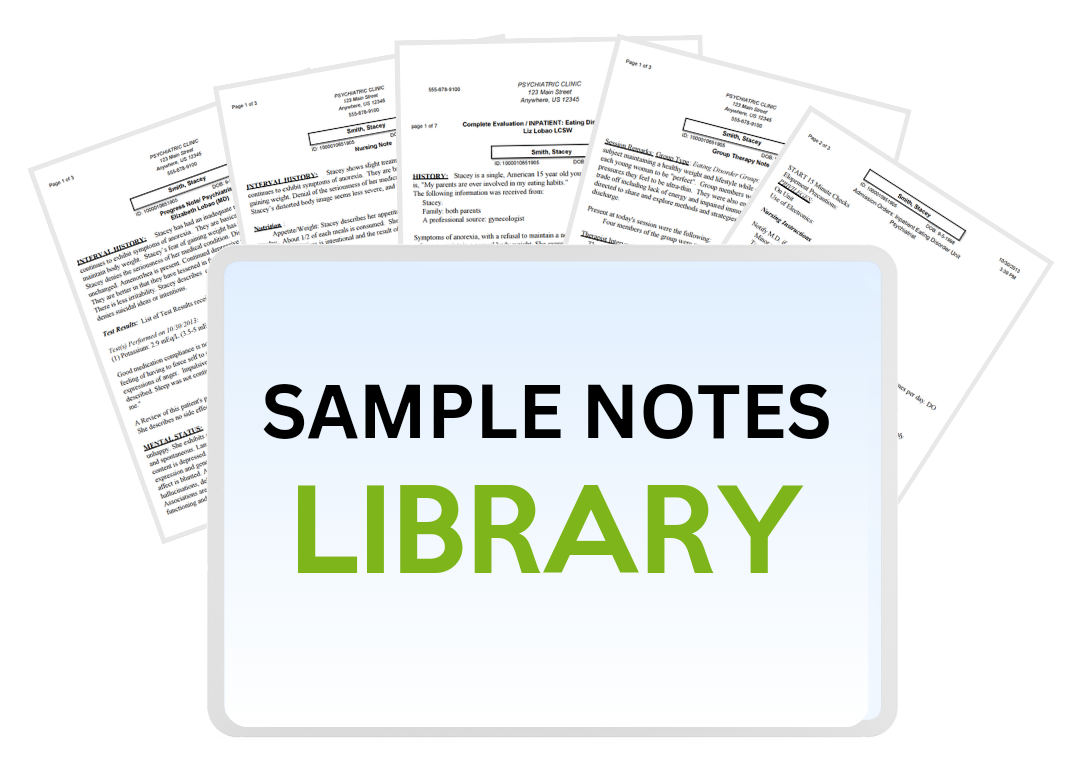
6 Tips for Success
Every therapist will have a preference for how they write their notes, but with these six tips, you can make your substance abuse documentation better and more effective:
- Pick a topic for each session: Between you and your client, decide what you want to focus on for each appointment and try to stick only to that. It can be a certain event, a new concern or other key details your client has on their mind. By focusing on one topic, you can simplify your notes.
- Use a template: Whether you choose to write DAP notes or SOAP notes, using a template can keep your notes organized and concise. Stick to two to three sentences for each section if possible so you can quickly review your notes when needed.
- Set a timer: To avoid overwriting or taking too long with your notes, setting a timer for 10 or 20 minutes can be helpful. If you cannot finish your note in that timeframe, assess where you spend the most time on your notes and how you can make them more concise.
- Meet with a colleague or supervisor to do a chart review: If you're not feeling confident in your note-writing abilities, getting feedback from a fellow therapist or supervisor can help you determine where you can improve.
- Remain professional: Because your client, colleagues or insurance companies may view your notes, remain professional when documenting your observations. Avoid overly negative language, jargon, unique acronyms or anything that sounds like a personal opinion or judgment. Stick to commonly used grammar and terminology so all team members who might read your notes can understand them.
- Introduce EHR software to make note-writing easier: Relying on a robust, intuitive electronic health records (EHR) system that provides templates for note-writing can make your substance abuse notes more efficient. Whether you need to make notes about symptoms, mental health exams, diagnoses, treatment plans or interventions, you can seamlessly document your notes and keep them organized.
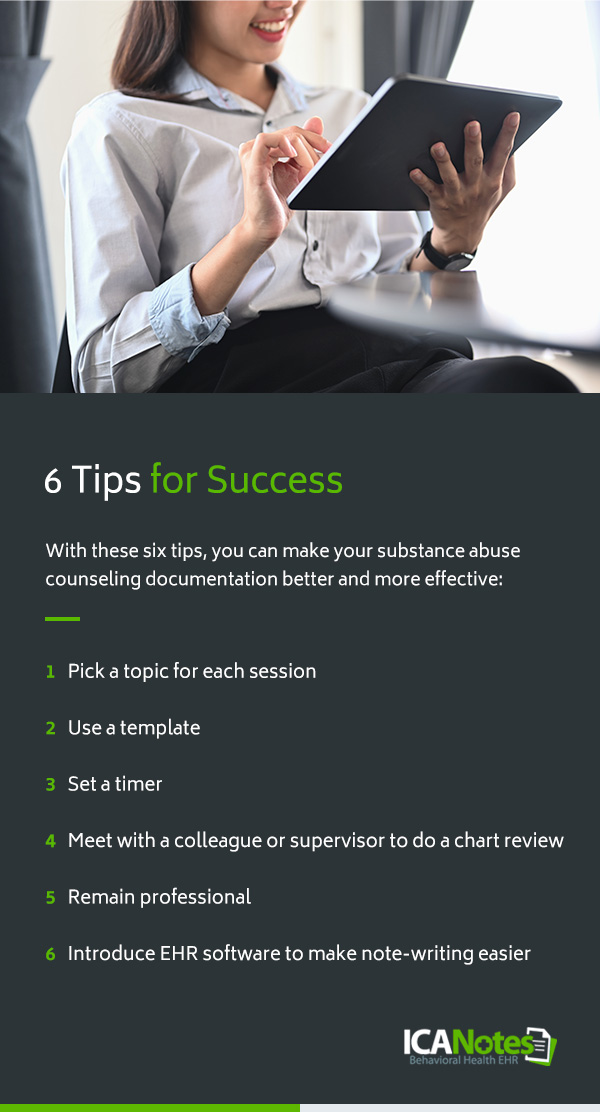
Frequently Asked Questions: Substance Abuse Notes
How ICANotes Simplifies Substance Abuse Documentation
Behavioral health documentation doesn’t have to feel like paperwork. With ICANotes, clinicians can create complete and compliant substance abuse notes in minutes.
Here’s how ICANotes streamlines the process:
-
Prebuilt Templates: Structured for addiction counseling, group therapy, and relapse prevention.
-
Customizable Prompts: Adapt note fields to match your clinical style or agency requirements.
-
Audit-Ready Formatting: Automatically aligns with payer expectations for medical necessity.
-
Secure Cloud Access: Document sessions anywhere, whether telehealth or in-office.
ICANotes ensures your substance abuse progress notes stay accurate, efficient, and defensible — freeing you to focus on client recovery, not documentation.
Ready to save time on documentation?
Start your free trial of ICANotes today and experience a faster, more compliant way to write substance abuse notes.
Start Your 30-Day Free Trial
Experience the most intuitive, clinically robust EHR designed for behavioral health professionals, built to streamline documentation, improve compliance, and enhance patient care.
- Complete Notes in Minutes - Purpose-built for behavioral health charting
- Always Audit-Ready – Structured documentation that meets payer requirements
- Keep Your Schedule Full – Automated reminders reduce costly no-shows
- Engage Clients Seamlessly – Secure portal for forms, messages, and payments
- HIPAA-Compliant Telehealth built into your workflow
Complete Notes in Minutes – Purpose-built for behavioral health charting
Always Audit-Ready – Structured documentation that meets payer requirements
Keep Your Schedule Full – Automated reminders reduce costly no-shows
Engage Clients Seamlessly – Secure portal for forms, messages, and payments
HIPAA-Compliant Telehealth built into your workflow
Related Posts
About the Author
Dr. October Boyles is a behavioral health expert and clinical leader with extensive expertise in nursing, compliance, and healthcare operations. With a Doctor of Nursing Practice (DNP) and advanced degrees in nursing, she specializes in evidence-based practices, EHR optimization, and improving outcomes in behavioral health settings. Dr. Boyles is passionate about empowering clinicians with the tools and strategies needed to deliver high-quality, patient-centered care.








